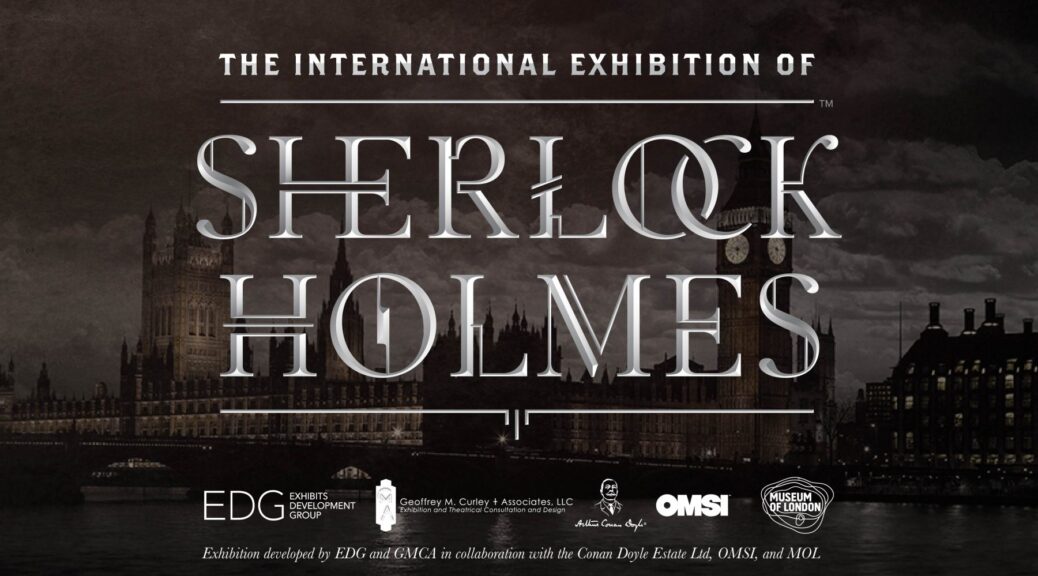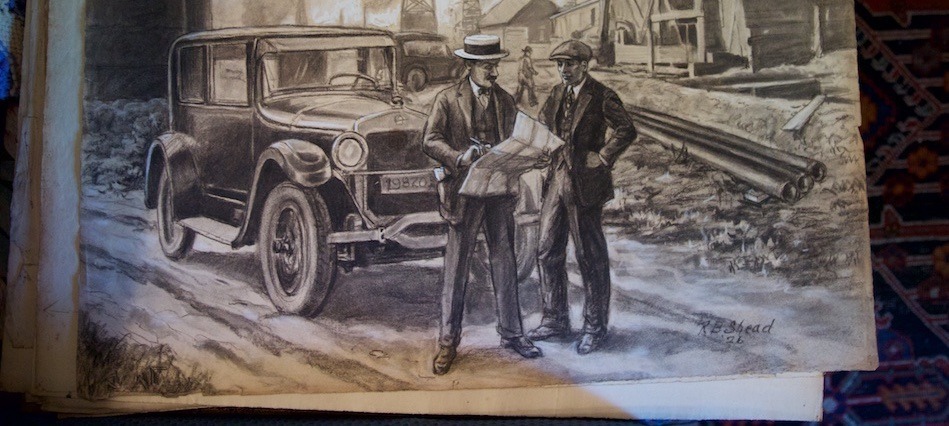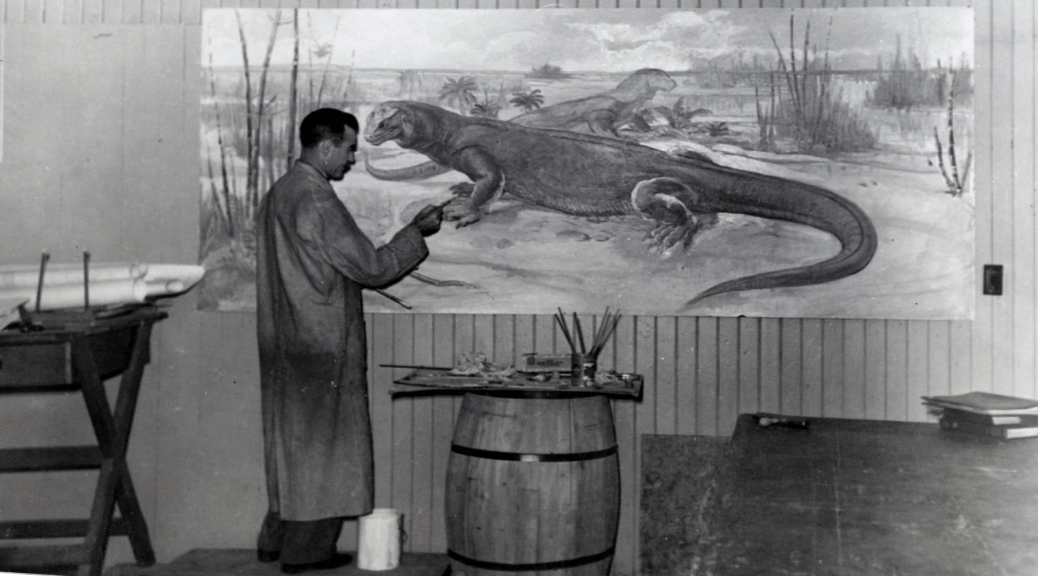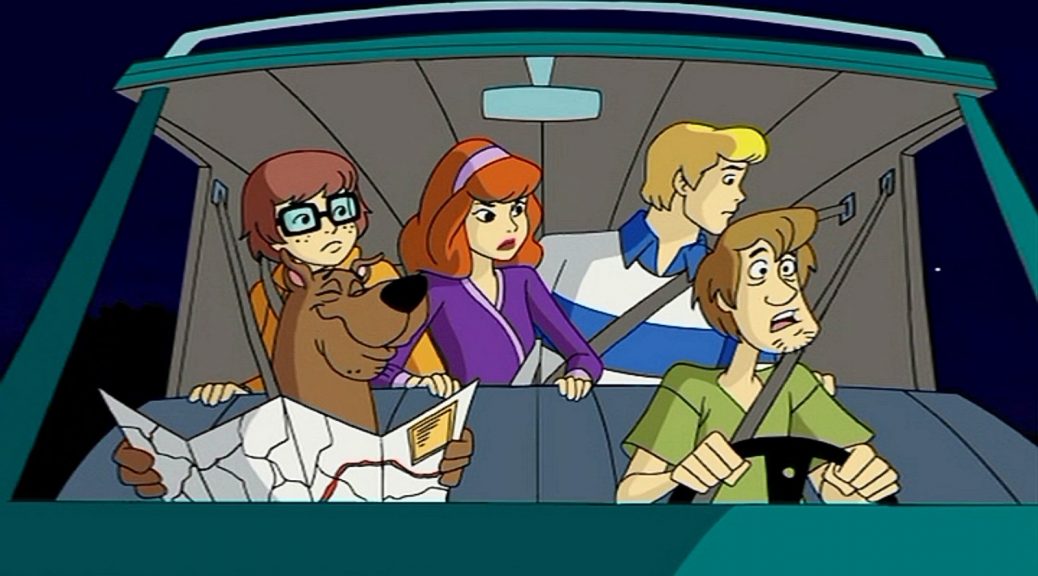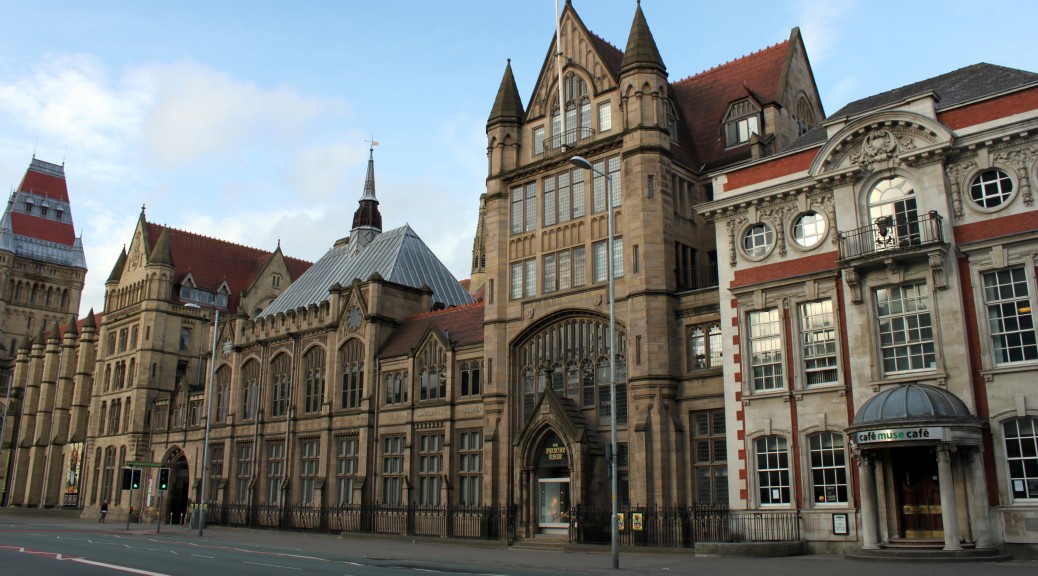I’ve been sitting on this for over a month. Well, not sitting, more cobbling together thoughts and experiences from over 15 years of knowing, learning from, and working with Dr. Jim Westgate.
Continue reading My Mentor; My FriendCategory Archives: Museums
The Game is Afoot
Sherlock Homes – The Exhibition recently opened at the Science Museum Oklahoma. A few days before the public opening I was invited to a pre-opening event and got to run through the exhibit with an exhibits colleague from the Sam Noble Museum of Natural History. It’s a wonderful little exhibit with an added interactive component that puts a notebook in guests’ hands and puts them on the case. You then move through the exhibit learning about botany, ballistics, blood-spatter, and even things that aren’t alliterative.
Summer at the Museum
I was originally just going to throw some fun screen grabs from these early time machine Phineas and Ferb episodes up on the Paleo Porch facebook page and be done. While going through the episodes for the shots though I noticed there was more to say and show about the museum than just the “back-in-time-with-dinosaurs” trope.
R.B. Shead: Pre-Museum Years
Several days after visiting with Ralph’s great nephew, Bill, he called me to say he had found a small watercolor study for one of the old museum dioramas and a few charcoal studies that Ralph had done as a student and others that were originals submitted as accompanying illustrations for short stories.
I was finally able to go back with my camera and take better photos of the paintings as well as look at these new finds. Those “few” sketched turned out to be an enormous century-old portfolio filled with over 100 pieces of art that Ralph had done either for story illustrations, studies, or magazine cover layouts. I was in awe.
The 12+ labors of Ralph B. Shead
For me, History is filled with people and things. I have never really indulged in the movements and theories and isms that seem to infect the past presently. For a historian this is a professional character defect, for me it is what brings history alive and allows us to find our connections to it. It is likely why I spent so much time learning archaeology and paleontology. I believe it is ultimately what lead me to the history of science so I could talk about all of that at once.
When I first came to OU and was getting settled across campus with the few people I had some connection with I was shown around the Sam Noble Natural History Museum. On the second floor back in the hallway to the VP lab and collections there are these two enormous paintings (13.5 feet long by 3.5 feet high). After taking in the scale and content of these behemoths I immediately looked for the signature. “Ralph B. Shead ’42” and “Ralph B. Shead ’34 (or 39 it is obscured by the frame I believe it is 34).
C’mon Get involved ’till the mystery is solved…
Continuing with the Scooby Doo theme here I get to update one of the most exciting stories that has happened since my time here. You remember my last lament of the missing murals? Well guess what isn’t “missing” anymore!
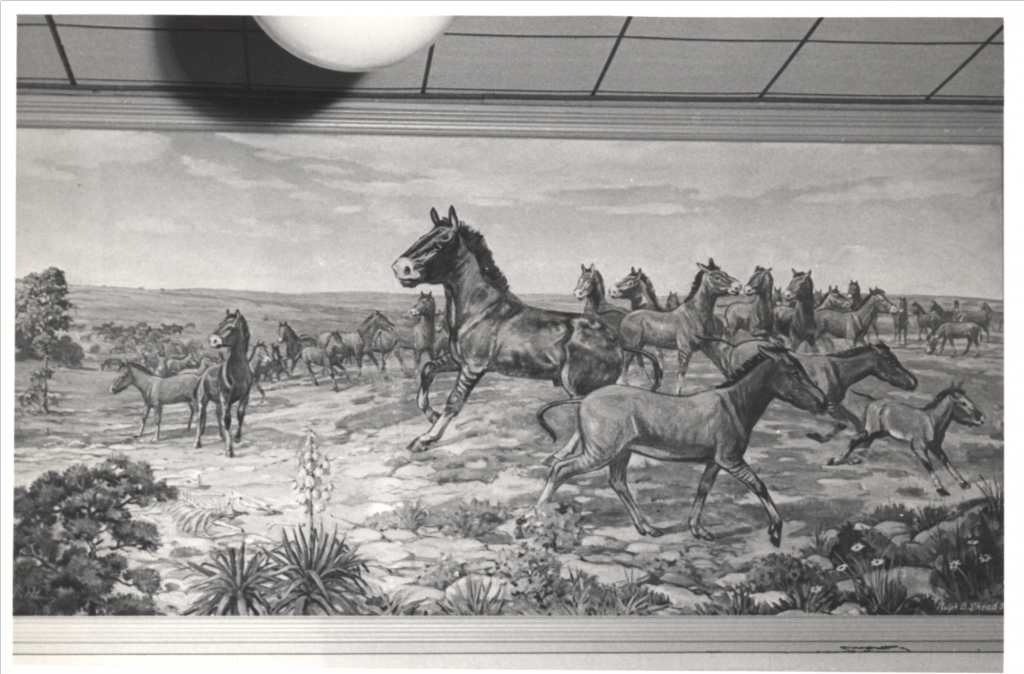
Scooby Doo & the Missing Paleontology Murals
This all started with a mammoth butt.
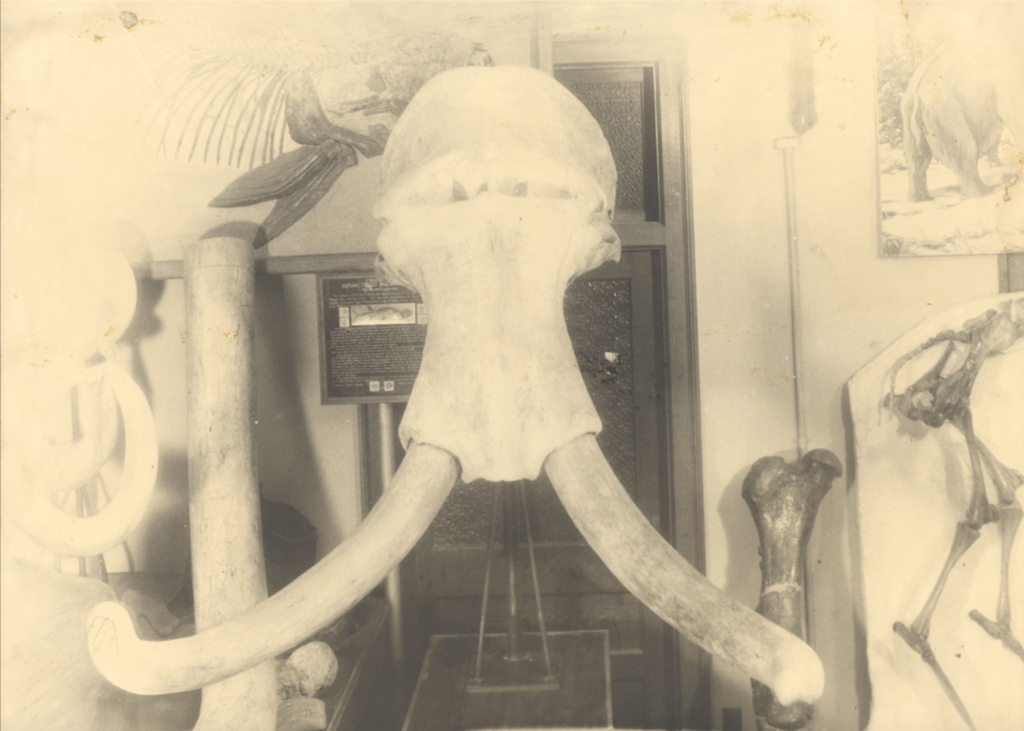
Some time back (2 years!) I began a project at our natural history museum to scan, digitize, archive, collect all of the images and negatives that were in our Vertebrate Paleontology collection. Thousands of images later a couple things really stand out: The importance of the WPA in the growth of out collections (see WPAleontology) and a couple of large paintings had disappeared since the late 30s and early 40s.
Continue reading Scooby Doo & the Missing Paleontology Murals
Prehistory and Paleolithic Pop Culture

Turns out Hugh Hudson has a new film out that focuses on the discovery of the prehistoric cave paintings in Altamira. If you aren’t familiar with the discovery, the Cliff Notes version is an 8 year old girl named Maria led her father Marcelino Sanz de Sautuola to a cave which held amazing paleolithic paintings of bison among other wonders; scientific debates ensue.


The end of the 19th century was rife with debates on man’s place in nature as well as the entire story of mankind in general. The established French view was that prehistoric humans were incapable of such higher forms of thought required to create such things. Arguments about the past and the professional nature of the scientists and divided disciples were heated, marked, and many times personal. Paleoanthropology and other disciplines as we know them were in their infancies fetal stages and battle for the authority to pontificate on humanity’s past was as much the prize as finding answers to the questions they were asking.


Having done a fair amount of research on the Piltdown Affair and its context within the debates that came to a head because of find like Altamira, I am especially intrigued. Adding to that is the fact that like so many other important discoveries in this period it was made by an amateur. That is to say it was reported by an amateur since it was originally discovered by a child.
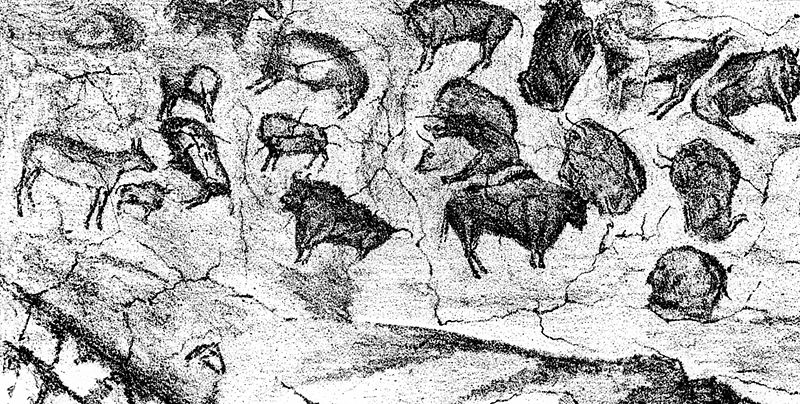
The movie itself looks wonderful since it will have the debates and forces of will involved (including the Church). It also included the wonder that fills Maria as the bison from the cave come alive in her dreams and become a part of her.

As with most things in life I didn’t get to this from any direct route. I actually first heard of this film through a trailer for its soundtrack. As bizarre as soundtrack trailers sound the bits and pieces around it are where I can glean more of the story.
Mark Knopfler and Evelyn Glennie worked together to create the score for the film and it sounds incredible. It was on Mark’s official Facebook page that I first say the trailer to the soundtrack. Complete with the reimagined stylized version of the famous bison on the front.
The bison form Altamira are iconic and you may recognize them from the plethora of Bisonte cigarette ads/packs that are everywhere. (I say everywhere, that may only be the case if you are as interested in Spain as I am). If not everywhere then at least on cigarettespedia.com which is a more useful website than you may think, especially for someone who studies visual culture.
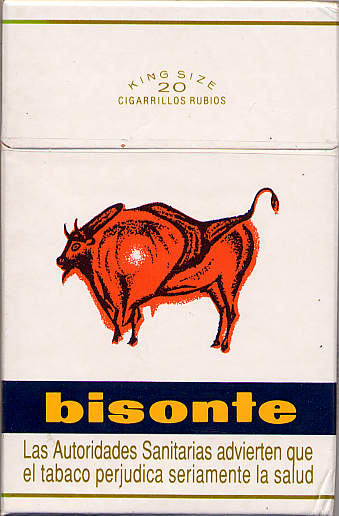
Getting to the heart of the film is difficult since all the available trailers are in Spanish since it was released there at the first of this month (April 2016). This isn’t because the film is in Spanish, but because of locality (I guess). So the trailers are dubbed into Spanish which just strikes me as odd, even if I am appreciative of the fact that was produced in English.
There are a few English clips that are part of the making of the soundtrack video below where I grabbed some of the above photos. As far as the cave itself goes, it remains closed to visitors since the damage it sustained from visitor’s breathing in the 1960s. The museum close by has a full replica included some sculptures of human faces that you couldn’t get to in the cave itself. There are also reproductions in Madrid, Germany, and most recently Japan. The Caves were up for reopening to the public a few years ago, but in an effort to preserve the site the decision was made to keep them closed. looking at a fake trope was still contentious in 2014.
The Cave was designated as a UNESCO World Heritage site in 1985 and they have a short video on it as well. Until it gets wider release this will have to suffice to piece together what is going on.
Update: Aug. 3, 2016 Full length English trailer finally hits youtube.
Nature and Culture
What a way to end a season’s foray into the world of historic networks, correspondence, and collecting. After finishing Fan’s book, I did not image that there could be one with even more methodological examples of what I want to do. Samuel Alberti’s Nature an Culture is that book. It is exactly what I want to do in my own research only aimed at museums in the United States.

This book should be on every modern natural historians shelf, and the paperback is cheap enough on Amazon that it is an easy addition. This book is an institutional history of the Manchester museum, but is it also a biography of the objects inside the museum. Further still, it is a cultural history of the nature of collecting for museums. It is not hyperbole to say that this short book has something for nearly everyone.

The very first connection (and reaffirmation that I am traveling in the right circles for my project) came on page three where Alberti quotes Simon Knell: “Natural scientists, archaeologists, and art historians, in some respects, share a similar engagement with objects: they build whole subjects from material things” (3). If you have noticed there are many art related posts here, and it wasn’t until I came to the University of Oklahoma that I became more active in art history research. Having trained as a paleontologist and archaeologist prior to coming to Norman I was 2/3 whole so to speak. The work I have done in Art History here has seemed a natural extension of the work that I had done previously, and Alberti citing Knell may serve as an official (and independent) seal on my decision to have my outside dissertation committee member (and 1/3 of my graded comprehensive exams) filled by a prominent historian of Art and the American West.
Alberti is able to trace out nearly a century of change within one institution. Nothing related to the museum escapes his analysis–from the famous artifacts like the mummies down to the collections that never went on display. He also does not ignore the individuals who worked in and with the museum from the director down to the charwomen. This is the holistic approach that must be made in order to fully understand the world of museum histories and their place within the politics of a university, city, or nation.
The book is more a collection of essays than a standard narrative. The thread that weaves the entire collection together is the museum itself. The best way to describe it is to use the movie time-lapse example. In many movies, usually near the end, there is a dramatic time-lapse that brings the historical point of reference up to the modern. Usually this is a landscape shot which shows the varying skylines of a city. In the case of Nature and Culture it is almost the opposite. If we could create this effect we would see a hundred years of change within the building itself with its architecture maintaining our frame of reference.
The second instance of immediate endearment of this work came on page 5. “This way of studying the history of museums firmly links them to other spaces for collecting an display including zoos and menageries, even when curators were seeking to distinguish museums from such tawdry places” (5–emphasis mine). My first masters thesis, The People’s Zoo: William M. Mann, The National Zoo, and the Birth of American Wildlife Conservation, 1889-1960 (linked to proquest PDF), covered William Mann’s collecting for the National Zoo. I cannot describe the feeling you get when your past work comes back around to provide solid foundation for things that you have yet done. An added bonus was the records of the National Zoo. Since the zoo comes under the Smithsonian umbrella, much of the zoo’s official accounts and reports were recorded in yearly federal reports. The years of work within the federal records has also set me up nicely to work with the WPA records that will form the end of my dissertation on collecting.
The analysis of objects in this text pulls in my work on my second thesis The Gilded Skull in England’s Closet: Displaying Human Evolution at the American Museum of Natural History (which has yet to even make it to proquest or the library despite being deposited almost a year ago–it really is amazing that Lamar University has a more streamlined thesis process and binding options than the University of Oklahoma, but that is another issue) which covered the Piltdown Skull as an object with its own history and own biography. In this handy little book I have an incredible connection between my work done at Lamar University in Texas and the more recent years I have spent here. That fact alone serves to raise this book on my favorites list.
Alberti’s brief nod at the hunters as collectors rounds out the trilogy of points I would like to make. Those that were doing the collecting are generally left out of the equation that begins with the preparation of specimens. While Manchester had less active patron-hunters than either the American Museum of Natural History or the Smithsonian, that Alberti mentions their importance reveals much. To be fair, one of the most famous/infamous of the hunters for the American Museum and Smithsonian was none other than Theodore Roosevelt. There are examples of the friction between hunters and scientists in Britain however, most notably in the recent book Between Man and Beast (Doubleday, 2013). Monte Reel follows the story of Paul Du Chaillu, his gorilla hunting, and Richard Owen needing the specimen to make his point.
Museum history is one of those topics that require a more diverse “toolkit” to adequately understand. Alberti’s work should be part of any course that looks at museums, collecting, or objects. I would say that includes the early speaking tours that had specimens in tow. It should also be required text for almost any Museum Studies course. That it is a single museum that Alberti covers, is not as much of a weakness as one would think. It serves as an almost perfect case study to replicate with any other similar institution–and most of them are much more similar than they are different. Even with its peculiarity of being a British establishment, it will serve as a model for the museums here in the states. What makes it more difficult is, like baseball, the big museums in the US are separated by league–the American Museum of Natural History and the (National League) Smithsonian. There are many-many-more that will follow an almost identical curve of existence (adjusted only slightly for chronology) as the Manchester Museum, and Alberti has provided us all with the most efficient way to understand them in their entirety, as much as that is possible.
One Year On
In the year since I posted last, I have not only outfitted an more than modest sized traveling museum and finished a second MA, but was able to squeeze in a few shows for students as well. The greatest highlight to share is that in a couple weeks I will be presenting Paleo Porch at the Society of Vertebrate Paleontology Conference in Berlin, Germany. My abstract was accepted in the “Education and Outreach” session which is all poster format, but I will be going to discuss not only the outreach with traveling artifacts (in this case casts) but also how successful using the humanities to teach science outreach can be.
 |
| First “Paleo in the Park” |
 |
| Middle School |
 |
| Middle School |
 |
| Middle School |
 |
| Middle School |
 |
| University Talk |
 |
| University Talk |
 |
| University talk layout and Q&A |
 |
| Pre-Collegiate Class at University |
 |
| Pre-Collegiate Class at University |
 |
| Pre-Collegiate Class at University |


